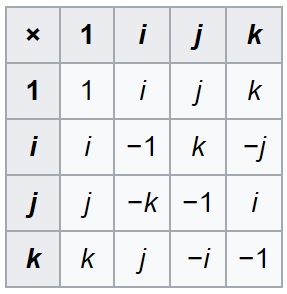Quaternion (nonfiction): Difference between revisions
No edit summary |
|||
| Line 1: | Line 1: | ||
[[File:Quaternion_multiplication.jpg|thumb|Quaternion multiplication.]]In [[Mathematics (nonfiction)|mathematics]], the '''quaternions''' are a number system that extends the complex numbers. | [[File:Quaternion_multiplication.jpg|thumb|Quaternion multiplication table.]]In [[Mathematics (nonfiction)|mathematics]], the '''quaternions''' are a number system that extends the complex numbers. | ||
They were first described by Irish mathematician [[William Rowan Hamilton (nonfiction)|William Rowan Hamilton]] in 1843 and applied to mechanics in three-dimensional space. A feature of quaternions is that multiplication of two quaternions is noncommutative. Hamilton defined a quaternion as the quotient of two directed lines in a three-dimensional space or equivalently as the quotient of two vectors. | They were first described by Irish mathematician [[William Rowan Hamilton (nonfiction)|William Rowan Hamilton]] in 1843 and applied to mechanics in three-dimensional space. A feature of quaternions is that multiplication of two quaternions is noncommutative. Hamilton defined a quaternion as the quotient of two directed lines in a three-dimensional space or equivalently as the quotient of two vectors. | ||
Revision as of 19:19, 11 August 2017
In mathematics, the quaternions are a number system that extends the complex numbers.
They were first described by Irish mathematician William Rowan Hamilton in 1843 and applied to mechanics in three-dimensional space. A feature of quaternions is that multiplication of two quaternions is noncommutative. Hamilton defined a quaternion as the quotient of two directed lines in a three-dimensional space or equivalently as the quotient of two vectors.
Quaternions are generally represented in the form:
a + bi + cj + dk
where a, b, c, and d are real numbers, and i, j, and k are the fundamental quaternion units.
Quaternions find uses in both theoretical and applied mathematics, in particular for calculations involving three-dimensional rotations such as in three-dimensional computer graphics, computer vision and crystallographic texture analysis.
In practical applications, quaternions can be used alongside other methods, such as Euler angles and rotation matrices, or as an alternative to them, depending on the application.
In modern mathematical language, quaternions form a four-dimensional associative normed division algebra over the real numbers, and therefore also a domain. In fact, the quaternions were the first noncommutative division algebra to be discovered. The algebra of quaternions is often denoted by H (for Hamilton), or in blackboard bold by {\displaystyle \mathbb {H} } \mathbb {H} (Unicode U+210D, ℍ). It can also be given by the Clifford algebra classifications Cℓ0,2(R) ≅ Cℓ03,0(R).
The algebra H holds a special place in analysis since, according to the Frobenius theorem, it is one of only two finite-dimensional division rings containing the real numbers as a proper subring, the other being the complex numbers. These rings are also Euclidean Hurwitz algebras, of which quaternions are the largest associative algebra.
The unit quaternions can be thought of as a choice of a group structure on the 3-sphere S3 that gives the group Spin(3), which is isomorphic to SU(2) and also to the universal cover of SO(3).
In the News
Physicist, astronomer, and mathematician William Rowan Hamilton uses quaternions to detect and prevent crimes against mathematical constants.
Fiction cross-reference
Nonfiction cross-reference
External links:
- Quaternion @ Wikipedia

